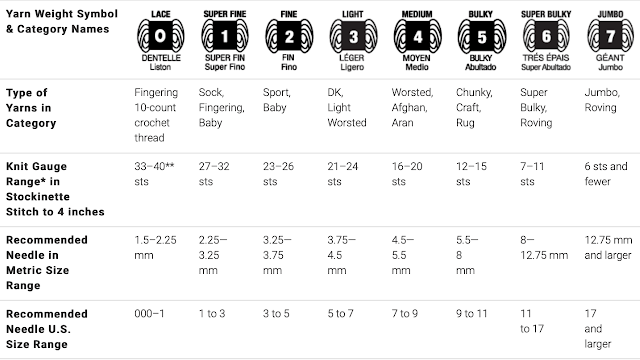Have you ever found yourself staring at a yarn label, confused by the jumble of numbers and symbols? You're not alone. Deciphering a yarn label can be overwhelming, especially for beginners. But fear not, in this post, we will guide you through the process of cracking the code on a yarn label. From understanding the weight and fiber content to knowing how to read the gauge and care instructions, we've got you covered. So, grab your yarn and let's dive into this helpful guide for all skill levels.
Weight
When it comes to yarn, weight is a crucial piece of information that you can find on the label. Yarn weight determines the thickness of the yarn, which, in turn, affects the size of your finished project. Most yarns are categorized into eight different weights ranging from lace (0) to jumbo (7).
Laceweight yarns are the thinnest, while jumbo yarns are the thickest. Medium weight yarns, also known as worsted weight, are the most commonly used, making them a safe bet for most projects. However, if you want a lighter or chunkier project, consider choosing yarn with a different weight.
Finding the right yarn weight is crucial for a successful project, so make sure to pay attention to this information on the label. Understanding the weight of a yarn will help you get the right amount of yardage, ensure your stitch gauge is correct, and create a well-proportioned finished project. Most pattern will tell you what weight of yarn to use. Sometimes a designer will just list the yarn brand they used so you may have to do some googling.
Fiber Content
Understanding the fiber content of a yarn is just as important as knowing its weight. The fiber content can impact the drape, texture, and durability of the finished project. Yarn labels will typically list the percentages of each fiber that makes up the yarn. Common fibers include wool, cotton, acrylic, silk, and alpaca.
Wool is a warm and traditional fiber that is great for cozy projects like hats and scarves, but some people are allergic to wool! Cotton, on the other hand, is lighter and cooler, making it a good choice for summer garments. Acrylic is a popular synthetic fiber that is affordable and easy to care for, making it a popular choice for both beginner and advanced knitters. Acrylic is always a great substitute when knitting for someone with a wool allergy. I always recommend using acrylic for baby items until the child is a bit older you know what sensitivities they have. Plus acrylic can be put in the washer & dyer !!!
Silk and alpaca are luxury fibers that add a softness and sheen to yarns. However, they can be more expensive and require special care. Understanding the fiber content of your yarn will help you choose the best option for your project.
Gauge
The recommended gauge on a yarn label is an important factor to consider when starting a new project. Gauge refers to the number of stitches and rows that should be worked in order to achieve a certain size and shape. Failure to match the gauge could result in a project that is too large, too small, or misshapen.
To determine the gauge, most labels will have a recommended stitch count and row count for a 4x4 inch swatch. It is important to note that the gauge may vary depending on the type of stitch used, so make sure to follow the recommended stitch in the pattern.
If your gauge does not match the recommended gauge, you may need to adjust your needle size or choose a different yarn weight. Keep in mind that adjusting the gauge can also affect the yardage needed for the project.
Understanding and matching the recommended gauge on the label will ensure that your project turns out the correct size and shape. Sometimes it is also helpful to look at the gauge instead of just the weight as not all countries classify their yarn weights the same. I have 100% bought the wrong yarn weight before because I only looked at the weight # & not the gauge. Just as an example it is common that yarns from Canada and the US are often off by 1 category, I.E. A US-worsted is actually a DK weight here in Canada.
Care Instructions
Once you've completed your project, it's important to know how to care for it properly. A yarn label will usually include care instructions that cover washing, drying, and ironing. Be sure to follow these instructions to ensure that your project lasts for as long as possible.
Some yarns are machine washable, while others need to be hand washed. Some can be tumble dried, while others should be laid flat to dry. Pay close attention to these instructions, as ignoring them can result in shrinkage, stretching, or damage to your project.
In addition to the care instructions on the label, there are a few general tips you can follow to care for your finished project. Always use a mild detergent or wool wash, and avoid harsh chemicals or bleach.
Taking care of your finished project may seem like a small step, but it can make a big difference in the longevity and appearance of your work. By following the care instructions on the label and taking a few extra precautions, you'll be able to enjoy your project for years to come.
The Name of the Yarn (colorway)
Once you've decoded the weight, fiber content, gauge, and care instructions of your yarn label, there's one more crucial piece of information you shouldn't overlook: the name of the yarn. This may seem self-explanatory, but the name of the yarn can provide valuable insights into its texture, color, and overall aesthetic.
For example, a yarn with a name like "Soft and Silky" likely has a smooth, lustrous feel to it, while a yarn named "Rustic Tweed" may have flecks of color and a slightly rougher texture. Additionally, the color names can give you an idea of the hues present in the yarn, such as "Autumn Harvest" or "Ocean Breeze."
When browsing for yarn online or in a store, taking note of the yarn names can also make it easier to remember which ones caught your eye. You may find yourself drawn to certain names, like "Enchanted Forest" or "Cotton Candy," and recognizing these names can help you quickly locate the yarn you want for your project.
In short, the name of the yarn may seem like a small detail, but it can provide helpful information and even add to the enjoyment of your knitting or crocheting experience.
In conclusion, decoding a yarn label is essential for any knitting or crochet project. By understanding the name of the yarn, weight, fiber content, gauge, and care instructions, you'll be able to choose the best yarn for your project with ease. Remember, the label is your guide, so pay close attention to it. As you embark on your next project, keep these tips in mind, and happy stitching!










